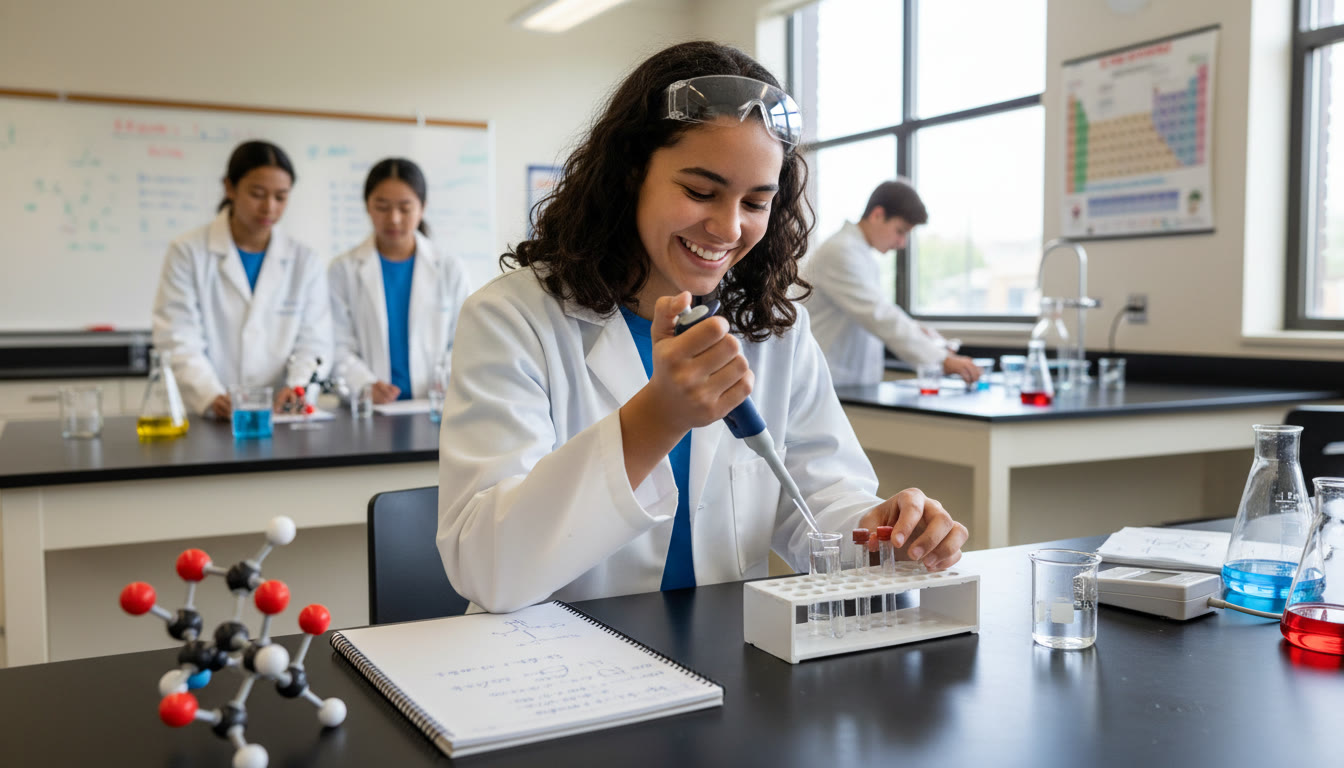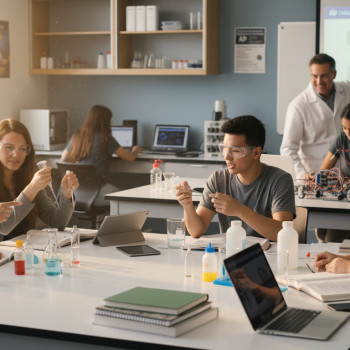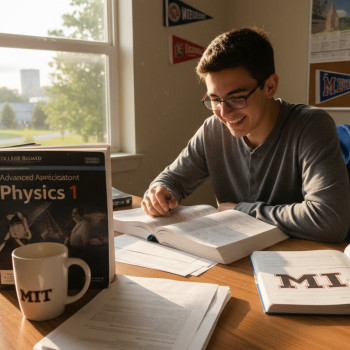AP Chemistry vs AP Physics: an honest conversation for future chemical and bioengineers
If you’re aiming for chemical engineering or bioengineering, you’ve probably been told to load up on math, science, and activities that scream “future engineer.” But when it comes to Advanced Placement courses, two big questions keep showing up: Should I take AP Chemistry or AP Physics (and which AP Physics — 1, 2, or C)? How will colleges see these choices? What will help me most in college and in admissions?
This post is written for students and parents who want a clear, human take — not a checklist of buzzwords. I’ll walk you through the content and skills of each course, how they relate to engineering majors, how to think about exam difficulty and college credit, study strategies you can actually use, and practical ways to align AP choices with your long-term goals. Along the way I’ll suggest study approaches — including where personalized, 1-on-1 tutoring (for example, Sparkl’s tailored tutoring and AI-driven insights) can make a real difference.
Start with the purpose: what do these courses teach you?
Both AP Chemistry and AP Physics aim to bring high-school students up to college-level thinking in their respective subjects. But the focus, modes of thinking, and day-to-day practice are different — and those differences matter for engineering.
AP Chemistry: what you’ll learn and why it matters for chemical/bioengineering
AP Chemistry covers the structure of matter, reactions, energetics, kinetics, equilibrium, acids and bases, and electrochemistry. The course is structured to develop chemical reasoning: interpreting models across scales (from electrons to bulk materials), quantitative problem solving, lab design, and data interpretation.
For chemical and bioengineering, AP Chem gives immediate payoff. You’ll build intuition about reaction mechanisms, thermodynamics, and material behavior — concepts you’ll encounter in transport phenomena, reaction engineering, biochemical processes, and materials science. AP Chem also trains you to move between qualitative explanations and quantitative calculations, a core engineering skill.
AP Physics: what you’ll learn and why it matters
AP Physics comes in several flavors. AP Physics 1 and 2 are algebra-based; AP Physics C (Mechanics and Electricity & Magnetism) is calculus-based and most directly aligned with college engineering tracks.
Physics teaches you to model systems, use conservation laws, and solve problems in dynamics, fluids, thermodynamics, optics, and electromagnetism. These are foundational for mechanical aspects of engineering design, instrumentation, electronics, and control systems—areas that chemical and bioengineers also encounter, especially in lab instrumentation, process control, and device design.
Side-by-side: content, mindset, and skills comparison
| Feature | AP Chemistry | AP Physics (1/2/C) |
|---|---|---|
| Core content | Atomic/molecular structure, reactions, equilibrium, kinetics, thermodynamics, electrochemistry | Kinematics, dynamics, energy, fluids, thermodynamics, electricity, magnetism, waves (AP Physics C adds calculus) |
| Math level | Algebra, strong emphasis on stoichiometry and algebraic manipulation; some calculus-flavored concepts | AP Physics 1/2: algebra-based. AP Physics C: calculus-based (closest to college engineering courses) |
| Problem style | Quantitative calculations and conceptual questions; labs and data analysis | Free-body diagrams, modeling, multi-step problem solving; experimental reasoning |
| Engineering relevance | Directly relevant to chemical reactions, process design, materials, and bio processes | Crucial for mechanics, instrumentation, and calculus-based modeling (Physics C highly relevant) |
| College prep value | Great preparation for freshman chemistry and many chemical engineering core classes | Physics C mirrors first-semester college mechanics and E&M; Physics 1/2 useful for conceptual grounding |
Which AP is more useful for chemical and bioengineering?
Short answer: both are valuable. The long answer depends on timing, your background, and where you want to be in college.
If you can take only one
Choose AP Chemistry if:
- You want direct overlap with core chemical engineering concepts (reactions, thermodynamics, material properties).
- Your school’s AP Physics offerings are limited to algebra-based versions and you’re aiming for engineering majors that expect calculus readiness.
- You enjoy lab work and mixing conceptual and quantitative chemistry problems.
Choose AP Physics C (if available) if:
- You’ve taken or are taking calculus and want the closest college-level physics experience.
- You’re curious about dynamics, E&M, or instrumentation and want to show colleges calculus-based coursework.
- Your intended engineering path includes heavy mechanics or device design (bioengineering device design, for instance).
If you can take two (ideal scenario)
Many successful applicants take both AP Chemistry and at least one AP Physics course. If scheduling permits, an ideal sequence might be:
- AP Chemistry in junior year to build chemistry foundations.
- AP Physics C in senior year alongside or after calculus to showcase rigorous, calculus-based problem solving.
This combination signals both content knowledge and mathematical maturity — a strong message to engineering programs.
How colleges interpret AP choices for engineering applicants
Admissions officers look for intellectual curiosity, academic rigor, and readiness for demanding STEM coursework. For engineering applicants, the selection of challenging, relevant AP classes matters more than simply piling on APs. Admissions readers appreciate:
- Depth in relevant subjects (chemistry and calculus-based physics for chemical/bioengineering).
- Strong performance in mathematics (AP Calculus AB/BC) because engineering hinges on math.
- Evidence of lab or project experience that complements course choices.
AP exam scores can sometimes yield college credit or placement, but policies vary by school and department; many engineering programs prefer placement in advanced sequences rather than credit. At highly selective programs, APs strengthen the academic narrative more than guarantee credit.
Study strategies tailored to each AP
Both exams reward practice, but the most effective preparation targets the unique demands of each course.
AP Chemistry study plan highlights
- Master dimensional analysis and unit conversions — many mistakes come from sloppy units.
- Practice multi-step stoichiometry and limiting reagent problems until they’re second nature.
- Build conceptual maps: link thermodynamics, kinetics, and equilibrium so you can see how changing a condition shifts a reaction.
- Do lab-style questions that require designing an experiment or interpreting data; free-response chemistry often tests experimental reasoning.
- Use past FRQs to learn how answers are scored — structure your written solutions with clear reasoning and units.
AP Physics study plan highlights
- Create a consistent problem-solving framework: draw diagram, list knowns and unknowns, choose laws, solve, check units and limits.
- For AP Physics C, train with calculus — practice derivatives and integrals in physics contexts (work, center of mass, circuits).
- Practice free-response problems under timed conditions. Physics solves best when you break problems into bite-sized physical principles.
- Work on multiple representations — graphs, free-body diagrams, equations — and move fluently between them.
How to use practice tests effectively
Raw practice is only helpful if you learn from it. When you take a practice test:
- Simulate timing and conditions to build stamina.
- Spend at least as much time reviewing mistakes as taking the test. Write out why a wrong answer was wrong and what rule or misconception led you there.
- Track recurring error patterns (e.g., algebra errors, conceptual misunderstandings, unit mistakes) and make a targeted remediation plan.
Lab work and project experience: the extra edge
AP courses include lab practices; more importantly, independent projects and extracurricular labs can show initiative and context on applications.
- Consider a small independent study or summer research project related to chemistry or bioengineering. Even a month-long project where you document methods and results is meaningful.
- In classroom labs, document your thinking: hypothesis, methods, uncertainties, and what you’d change next time. That kind of reflection builds the scientific reasoning that both APs test.

Time management and course sequencing
Plan your course load with an eye to building math and lab foundations before tackling calculus-based physics or advanced chemistry topics.
- Take Algebra II or Precalculus early; aim to be enrolled in Calculus (AB or BC) before or during AP Physics C.
- AP Chemistry pairs well with concurrent or prior AP Biology for students leaning toward bioengineering.
- Keep one semester lighter in your senior year if you plan major admissions activities (apps, interviews, senior projects).
When personalized tutoring makes sense — and how it helps
Self-study and classroom instruction will take you far, but targeted tutoring accelerates progress in specific areas. Personalized 1-on-1 tutoring can:
- Identify and close conceptual gaps quickly (for example, stoichiometry misconceptions or weak free-body diagram skills).
- Create tailored study plans that fit your school calendar, strengths, and weak points.
- Offer expert tutors who bridge high-school AP expectations and college-level thinking; some tutoring programs (like Sparkl’s) combine expert tutors with AI-driven insights to personalize pacing and practice.
Tutors are especially useful if you’re aiming for top programs where small differences in performance and demonstrated depth can matter. The goal isn’t tutoring for the score alone; it’s tutoring to build habits and intuition that carry into freshman engineering courses.
Real-world examples: how AP choices play out
To make this concrete, here are three typical student scenarios and recommended AP paths.
- The chemistry-first student: Loves reactions and lab work. Took AP Chemistry junior year, got a strong score, then took AP Physics 1 senior year. This student is well-prepared for chemical engineering core classes and can pivot to bioengineering with an extra biology-focused course.
- The calculus-ready student: Took Calculus BC junior year, then AP Physics C senior year and AP Chemistry concurrently. This student demonstrates rigorous math ability and solid coverage of both physics and chemistry — an ideal profile for top engineering programs.
- The exploratory student: Unsure between chemical engineering and biomed. Took AP Biology and AP Chemistry to test interest, then added AP Physics 1 to round out physics understanding. This path keeps options open while building relevant foundations.
Common myths and honest truths
Myth: “AP scores guarantee college credit.” Truth: Credit and placement policies vary widely. Some engineering departments accept AP scores for placement only; others won’t count them toward major requirements. Always check target schools’ policies.
Myth: “More APs always look better.” Truth: Admissions value relevance and performance. A focused set of relevant APs with strong grades and scores beats a long list of weakly related APs.
Practical checklist for making your decision
- Check prerequisites: Are you enrolled in or finished with calculus? If yes, prioritize Physics C if available.
- Ask your guidance counselor and check college course expectations for your target programs.
- Look at the workload: can you sustain AP labs and timed practice alongside extracurriculars?
- Plan labs and projects that show depth — an independent lab notebook, a science fair project, or a small research internship helps.
- Consider a tutor if you need targeted help. Sparkl’s personalized tutoring and tailored study plans can be a resource for focused 1-on-1 work and AI-informed practice recommendations.

Summary: a balanced, realistic recommendation
If you must pick one and your heart (or college targets) lean toward chemical or bioengineering, start with AP Chemistry. It gives the most direct content alignment to reaction engineering, thermodynamics, and lab skills. If you have calculus and the option for AP Physics C, take it too — calculus-based physics demonstrates the mathematical maturity engineering schools look for.
Above all, choose a path you can excel in. Depth, strong grades, reflective project work, and clear preparation for college coursework matter more than the sheer number of AP classes. Use practice tests wisely, do lab work that shows thinking, and consider personalized tutoring for focused gaps — one-on-one guidance and tailored study plans (with tools like AI-driven insights) can turn steady effort into real gains.
Final tips for parents and students
- Encourage thoughtful course selection rather than checkbox collecting. Ask: does this prepare me for freshman engineering coursework?
- Support consistent, weekly practice. AP mastery is a marathon, not a sprint.
- Prioritize wellbeing. High-achieving students burn out when they overload. A lighter senior year with depth is better than a packed schedule with diminishing returns.
- Use resources: class teachers, AP Classroom materials, targeted tutors, and structured study plans to make progress efficient.
Parting thought
Choosing between AP Chemistry and AP Physics isn’t a one-time checkbox — it’s part of shaping your academic identity as an aspiring engineer. Both courses teach you how to think like a scientist or engineer: to model, to test, and to refine. Pick the path that builds the strongest foundation for the engineering you want to do, keep learning deliberately, and don’t underestimate the power of focused guidance — whether from a teacher, mentor, or personalized tutoring program that meets you where you are.
Good luck — and remember: curiosity and disciplined practice are the habits that carry you from AP exams to engineering classrooms and beyond.























No Comments
Leave a comment Cancel